Episode 11 of a series on heat pumps in existing buildings focuses on heat pumps in multi-family houses.
Heat pumps are required in multi-family houses
Heat pumps have a very wide range of applications. The building sector is the most prominent example, but they are also deployed in industry, white goods, and electromobility. When they are used to provide heating, the focus has so far been on detached and semi-detached houses. These account for 82% of residential buildings in Germany. However, they account for less than 60% of the living space. Exactly 41% of the living space is provided by multi-family houses (MFH). Three-quarters of these are buildings with three to twelve residential units. These figures show, how important it is that heat pumps are utilized more often in multi-family houses – both in new and existing buildings.
The challenges
Heat pump systems can be used successfully in multi-family buildings. Numerous examples from European and Asian countries in different climate zones and with different urban planning conditions underscore this.
But, the challenges for deploying heat pump technologies and renewable energy in multi-family buildings are a bit more complex. The hurdles here are both administrative and technical. For example, the ownership of multi-family buildings can be diverse. They can be owned by the local municipality, a housing association, various apartment owners, or simply one investor. These owners have different interests and this often leads to decisions that are not optimal for climate protection. In addition, there are other challenges, such as logistical difficulties due to the large number of apartments affected, when renovation measures are to be carried out.
From the technological point of view, multi-family houses are a bigger challenge for heat pumps. Compared to detached houses, the necessary heating circuit temperatures are higher (at least for centralized solutions) due to distribution losses. The same applies to domestic hot water.. Due to the required higher heating capacity, the heat sources need to be sufficiently dimensioned, which can, cause a larger space requirement.
Possible solutions
However, there are already many good technological answers to the mentioned challenges. Selecting the “right” solution from the multitude of options is not always easy. For example, the high domestic hot water temperatures required due to legionella protection can be counteracted by decentralizing water heating, fresh water stations or the use of ultrafiltration.
A basic classification can help to create an overview and support the best decision in the different scenarios. The chart below is a result of an international research and development collaboration on the topic of “Heat pumps in multi-family buildings” (Annex 50 https://heatpumpingtechnologies.org/annex50/). The strong simplification of the chart leads to incompleteness but allows a clear grouping. The result shows five “solution families” for heat pumps in multi-family houses.
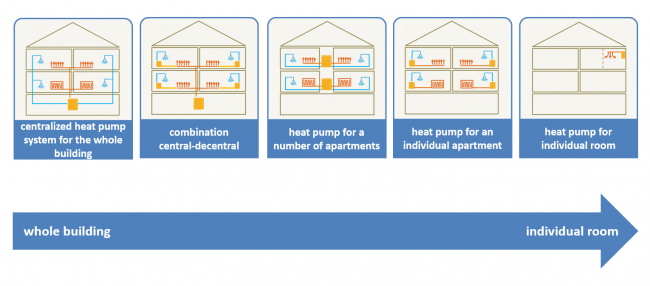
The possible form of applications of heat pumps are ordered along the line “whole building” to “single room”. A more detailed description of the solutions, including further options within each “solution family”, is currently in preparation and will be published as an interactive tool on the project website (link) in a few months.
Examples
In the context of the mentioned R&D project, a large number of examples of installations in different countries have been collected. The following interactive map shows the collected example applications of heat pumps in multi-family houses (see also https://heatpumpingtechnologies.org/annex50/case-studies/) . Especially impressive are the heat pump applications in – often not renovated – existing buildings. The case studies database is continuously expanded and supplemented. The responsible persons are pleased to receive new registrations of reference projects.
This episode almost marks the end of the blog series “Heat pumps in existing buildings” In the last episode, we will summarize the most important findings and give a brief outlook.
Further reading:
Overview on the range of applications for heat pumps.
Episode 10 of this series: Is it better to combine a heat pump with fossil heating in some cases?
Episode 9 of this series: Is it worth waiting for technological developments before switching for a heat pump?
Header picture: DEGEWO-Zukunftshaus in Berlin, Germany. Reference building of Bundesverband Wärmepumpe (BWP) e.V. © BWP.
This blog post is financially supported by the Climate Neutrality Foundation.

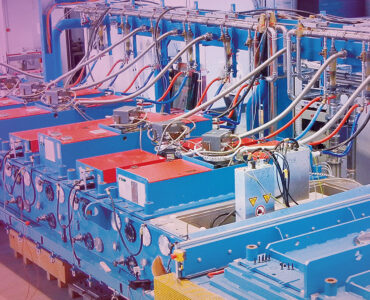

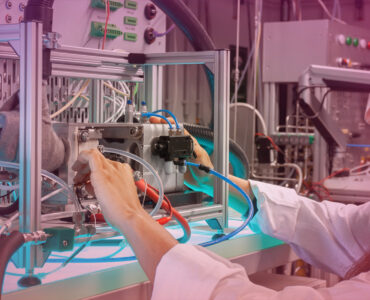



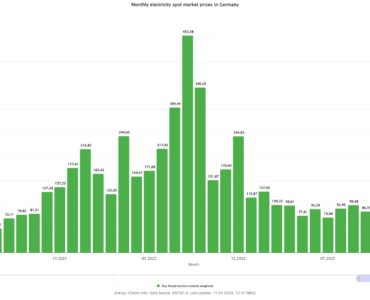
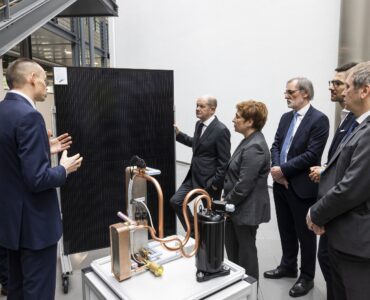
Very good. Many thanks.
Added to my list of things to rebut silly claims about heat pumps with!
Rgds
Damon
Only people trying to sell this Heat Pump Technology are pushing it. I do not believe its viable in the UK. Suddenly its the greatest thing since sliced bread. We would be better off using a different type of gas like Hydrogen.
Nonsense at several levels.
1) Counter example. I am not selling heat pumps. I continue to note that they are good and already have many many working instances in the UK. So your statement is wrong on those two counts.
2) About the only thing that could go in existing gas pipes (after some upgrades) is H2, other than anaerobic digest gas which seems unlikely to be able to scale, and the efficiency to electrolyse H2 and after burning is about 20% or less of that of running a heat-pump directly with the same electricity.
Really it sounds as if *you* have the axe to grind here, IMHO.
In fact as a number of studies and experience shows collective systems for Multi Family Buildings should be avoided as much as possible, especially when for DHW. This is possible for new buildings as well as for renovated buildings. When still a collective system is unavoidable for DHW there will be two options, either an open system where the circulated water is used by the end user (in hotels, hospitals, care homes), or when the circulated water is only an energy bearer transferring the heat to an individual end user. In the first case high temperatures are essential to avoid ledionella. In the second case the volume limitation concept limits the temperatures, as reported under Annex 46. However as a consequence of the demand for comfort high temperatures are delivered by the companies managing the system.